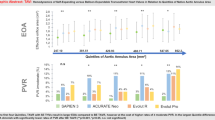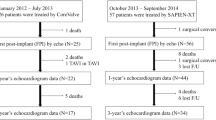Abstract
Transcatheter aortic valve implantation (TAVI) with self-expandable Medtronic CoreValve (MCV; Medtronic, Minneapolis, MN) or balloon-expandable Edwards SAPIEN XT valve (ESV; Edwards Lifesciences, Irvine, CA) has been widely used for treatment of high-risk patients with severe aortic stenosis (AS). There is limited data comparing the long-term hemodynamic performance of these two valves. Therefore, this study aimed to compare the short and long-term hemodynamic performance of TAVI with either MCV or ESV. A total of 78 patients who underwent TAVI in our center between June 01, 2012 and January 01, 2014 were enrolled in this retrospective study. For each of the patients we recorded the preprocedural echocardiographic data as well as the post-TAVI echocardiographic outcomes at day one, 6 months and 1 year. The MCV group had lower transaortic gradients than the ESV group, with respect to both maximum (13.4 ± 5.8 vs 18.7 ± 8.1 mmHg, p = 0.001) and mean values (6.5 ± 3.2 vs 9.4 ± 4.3 mmHg, p < 0.001) at post-TAVI day one. These values continued to be significantly lower in the MCV group during post-TAVI 6 months (p < 0.001) and post-TAVI 1 year follow-up (p < 0.05). A paravalvular leak (PVL, grade ≥2) was observed in 6.4 % of patients after TAVI; however, this value decreased over time, and there was no significant difference between the MVC and ESV groups (8.2 vs 3.4 %, p = 0.646). The MCV bioprosthesis was associated with lower transaortic gradients than those of the ESV throughout 1 year of follow-up. The incidence of PVL grade ≥2 in MCV and ESV was comparable.



Similar content being viewed by others
References
Leon MB, Smith CR, Mack M et al; PARTNER Trial Investigators (2010) Transcatheter aortic-valve implantation for aortic stenosis in patients who cannot undergo surgery. N Engl J Med 363:1597–1607
Smith CR, Leon MB, Mack MJ et al; PARTNER Trial Investigators (2011) Transcatheter versus surgical aortic-valve replacement in high-risk patients. N Engl J Med 364:2187–2198
Rodés-Cabau J (2011) Transcatheter aortic valve implantation: current and future approaches. Nat Rev Cardiol 9:15–29
Grube E, Schuler G, Buellesfeld L et al (2007) Percutaneous aortic valve replacement for severe aortic stenosis in high-risk patients using the second- and current third-generation self-expanding CoreValve prosthesis: device success and 30-day clinical outcome. J Am Coll Cardiol 50:69–76
Grube E, Buellesfeld L, Mueller R et al (2008) Progress and current status of percutaneous aortic valve replacement: results of three device generations of the CoreValve revalving system. Circ Cardiovasc Interv 1:167–175
Stokłosa P, Szymański P, Dąbrowski M et al (2015) The impact of transcatheter aortic valve implantation on left ventricular performance and wall thickness––single-centre experience. Postepy Kardiol Interwencyjnej 11:37–43
Moat NE, Ludman P, de Belder MA et al (2011) Long-term outcomes after transcatheter aortic valve implantation in high-risk patients with severe aortic stenosis: the UK TAVI (United Kingdom transcatheter aortic valve implantation) registry. J Am Coll Cardiol 58:2130–2138
Gilard M, Eltchaninoff H, Iung B et al; FRANCE 2 Investigators (2012) Registry of transcatheter aortic-valve implantation in high-risk patients. N Engl J Med 366:1705–1715
Nombela-Franco L, Ruel M, Radhakrishnan S et al (2013) Comparison of hemodynamic performance of self-expandable CoreValve vs balloon-expandable Edwards SAPIEN aortic valves inserted by catheter for aortic stenosis. Am J Cardiol 111:1026–1033
Abdel-Wahab M, Comberg T, Büttner HJ et al; Segeberg-Krozingen TAVI Registry (2014) Aortic regurgitation after transcatheter aortic valve implantation with balloon- and self-expandable prostheses: a pooled analysis from a 2-center experience. JACC Cardiovasc Interv 7:284–292
Chang HH, Chen IM, Chen PL, Hsu TL, Lin SM, Chen YH (2015) Comparison of balloon-expandable valves versus self-expandable valves in high-risk patients undergoing transcatheter aortic valve replacement for severe aortic stenosis. J Chin Med Assoc 78:331–338
Kasel AM, Cassese S, Ischinger T et al (2014) A prospective, non-randomized comparison of SAPIEN XT and CoreValve implantation in two sequential cohorts of patients with severe aortic stenosis. Am J Cardiovasc Dis 4:87–99
Godino C, Maisano F, Montorfano M et al (2010) Outcomes after transcatheter aortic valve implantation with both Edwards-SAPIEN and CoreValve devices in a single center: the Milan experience. JACC Cardiovasc Interv 3:1110–1121
Vahanian A, Alfieri O, Andreotti F et al (2012) Guidelines on the management of valvular heart disease (version 2012). Eur Heart J 33:2451–2496
Kasel AM, Cassese S, Bleiziffer S et al (2013) Standardized imaging for aortic annular sizing: implications for transcatheter valve selection. JACC Cardiovasc Imaging 6:249–262
Evangelista A, Flachskampf F, Lancellotti P et al (2008) European Association of Echocardiography recommendations for standardization of performance, digital storage and reporting of echocardiographic studies. Eur J Echocardiogr 9:438–448
Hahn RT, Abraham T, Adams MS et al (2013) Guidelines for performing a comprehensive transesophageal echocardiographic examination: recommendations from the American Society of Echocardiography and the Society of Cardiovascular Anesthesiologists. J Am Soc Echocardiogr 26:921–964
Clavel MA, Rodés-Cabau J, Dumont E et al (2011) Validation and characterization of transcatheter aortic valve effective orifice area measured by Doppler echocardiography. JACC Cardiovasc Imaging 4:1053–1062
Zamorano JL, Badano LP, Bruce C et al (2011) EAE/ASE recommendations for the use of echocardiography in new transcatheter interventions for valvular heart disease. J Am Soc Echocardiogr 24:937–965
Pibarot P, Dumesnil JG (2012) Doppler echocardiographic evaluation of prosthetic valve function. Heart 98:69–78
Zoghbi WA, Chambers JB, Dumesnil JG et al (2009) Recommendations for evaluation of prosthetic valves with echocardiography and Doppler ultrasound. J Am Soc Echocardiogr 22:975–1014
Spethmann S, Dreger H, Schattke S et al (2012) Doppler haemodynamics and effective orifice areas of Edwards SAPIEN and CoreValve transcatheter aortic valves. Eur Heart J Cardiovasc Imaging 13:690–696
Tanrıverdi Z, Dursun H, Kaya D (2015) Comparison of echocardiographic results of CoreValve versus Edwards SAPIEN valves in patients with bicuspid aortic valve. Catheter Cardiovasc Interv. doi:10.1002/ccd.26052
Athappan G, Patvardhan E, Tuzcu EM et al (2013) Incidence, predictors, and outcomes of aortic regurgitation after transcatheter aortic valve replacement: meta-analysis and systematic review of literature. J Am Coll Cardiol 61:1585–1595
Généreux P, Head SJ, Wood DA et al (2012) Transcatheter aortic valve implantation: 10-year anniversary part II: clinical implications. Eur Heart J 33:2399–2402
Hahn RT, Kodali S, Généreux P et al (2014) Paravalvular regurgitation following transcutaneous aortic valve replacement: predictors and clinical significance. Curr Cardiol Rep 16:475
Lerakis S, Hayek SS, Douglas PS (2013) Paravalvular aortic leak after transcatheter aortic valve replacement: current knowledge. Circulation 127:397–407
Dvir D, Barbash IM, Ben-Dor I et al (2013) Paravalvular regurgitation after transcatheter aortic valve replacement: diagnosis, clinical outcome, preventive and therapeutic strategies. Cardiovasc Revasc Med 14:174–181
Abdel-Wahab M, Mehilli J, Frerker C et al; CHOICE investigators (2014) Comparison of balloon-expandable vs self-expandable valves in patients undergoing transcatheter aortic valve replacement: the CHOICE randomized clinical trial. JAMA 311:1503–1514
O’Sullivan KE, Gough A, Segurado R et al (2014) Is valve choice a significant determinant of paravalvular leak post-transcatheter aortic valve implantation? A systematic review and meta-analysis. Eur J Cardiothorac Surg 45:826–833
Zegdi R, Lecuyer L, Achouh P et al (2010) Increased radial force improves stent deployment in tricuspid but not in bicuspid stenotic native aortic valves. Ann Thorac Surg 89:768–772
Tzamtzis S, Viquerat J, Yap J et al (2013) Numerical analysis of the radial force produced by the Medtronic-CoreValve and Edwards-SAPIEN after transcatheter aortic valve implantation (TAVI). Med Eng Phys 35:125–130
Jilaihawi H, Chin D, Spyt T et al (2010) Prosthesis-patient mismatch after transcatheter aortic valve implantation with the Medtronic CoreValve bioprosthesis. Eur Heart J 31:857–864
Ali OF, Schultz C, Jabbour A et al (2015) Predictors of paravalvular aortic regurgitation following self-expanding Medtronic CoreValve implantation: the role of annulus size, degree of calcification, and balloon size during pre-implantation valvuloplasty and implant depth. Int J Cardiol 179:539–545
Abdel-Wahab M, Zahn R, Horack M et al (2011) Aortic regurgitation after transcatheter aortic valve implantation: incidence and early outcome. Results from the German transcatheter aortic valve interventions registry. Heart 97:899–906
Tagaki K, Latib A, Al-Lamee R et al (2011) Predictors of moderate-to-severe paravalvular aortic regurgitation immediately after CoreValve implantation and the impact of postdilatation. Catheter Cardiovasc Interv 78:432–443
Bleiziffer S, Mazzitelli D, Opitz A et al (2012) Beyond the short-term: clinical outcome and valve performance 2 years after transcatheter aortic valve implantation in 227 patients. J Thorac Cardiovasc Surg 143:310–317
Kodali SK, Williams MR, Smith CR et al (2012) Two-year outcomes after transcatheter or surgical aortic valve replacement. N Engl J Med 366:1686–1695
Kapadia SR, Tuzcu EM, Makkar RR et al (2014) Long-term outcomes of inoperable patients with aortic stenosis randomly assigned to transcatheter aortic valve replacement or standard therapy. Circulation 130:1483–1492
Gurvitch R, Webb JG, Yuan R et al (2011) Aortic annulus diameter determination by multidetector computed tomogra-phy: reproducibility applicability and implications for transcatheter aortic valve implantation. JACC Cardiovasc Interv 4:1235–1245
Toggweiler S, Humphries KH, Lee M et al (2013) 5-year outcome after transcatheter aortic valve implantation. J Am Coll Cardiol 61:413–419
Author information
Authors and Affiliations
Corresponding author
Ethics declarations
Conflict of interest
Dr Dayimi Kaya is a clinical proctor for Medtronic Inc.
Informed consent
The Institutional Review Board granted approval of the study design and waived informed consent since solely data obtained in the context of clinical care is utilized.
Rights and permissions
About this article
Cite this article
Kaya, D., Tanriverdi, Z., Dursun, H. et al. Echocardiographic outcomes of self-expandable CoreValve versus balloon-expandable Edwards SAPIEN XT valves: the comparison of two bioprosthesis implanted in a single centre. Int J Cardiovasc Imaging 32, 1371–1378 (2016). https://doi.org/10.1007/s10554-016-0924-y
Received:
Accepted:
Published:
Issue Date:
DOI: https://doi.org/10.1007/s10554-016-0924-y




